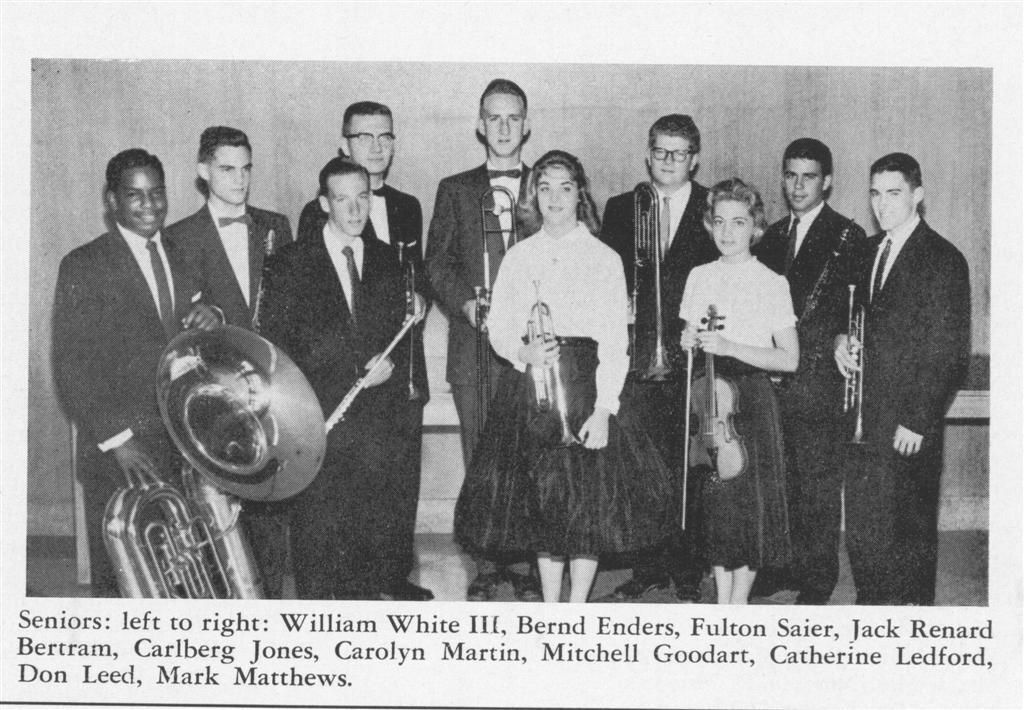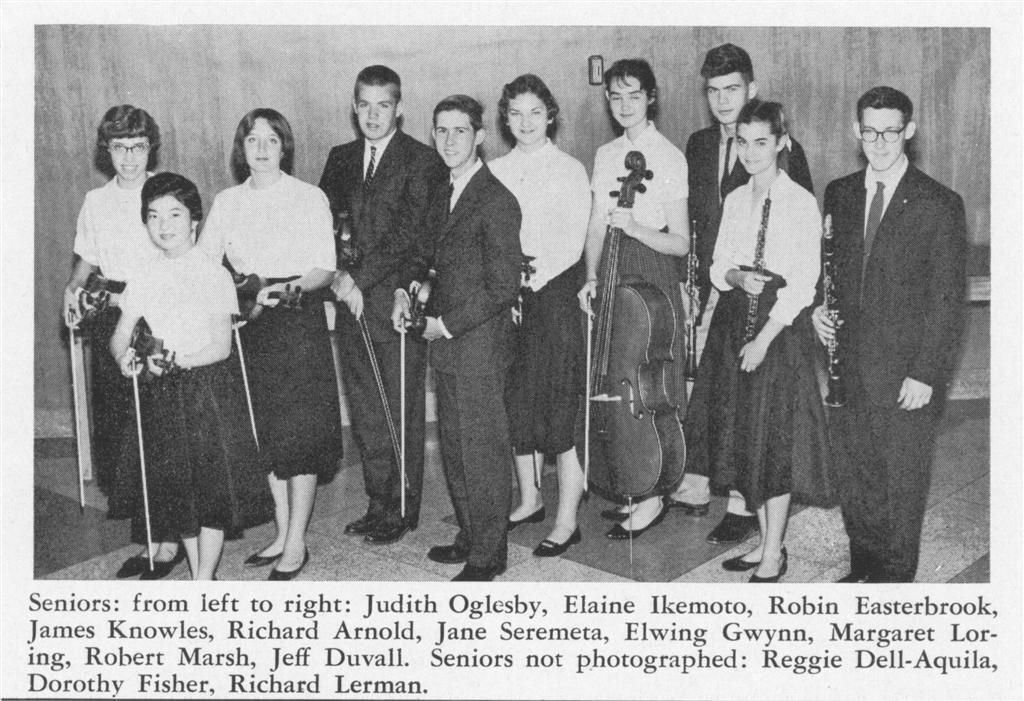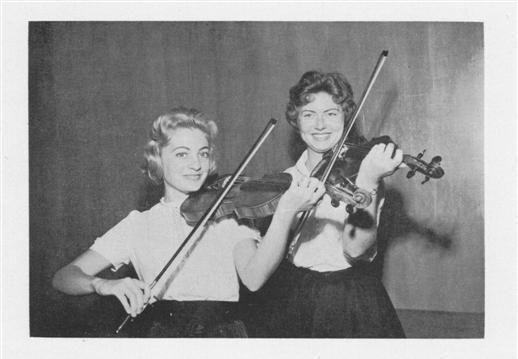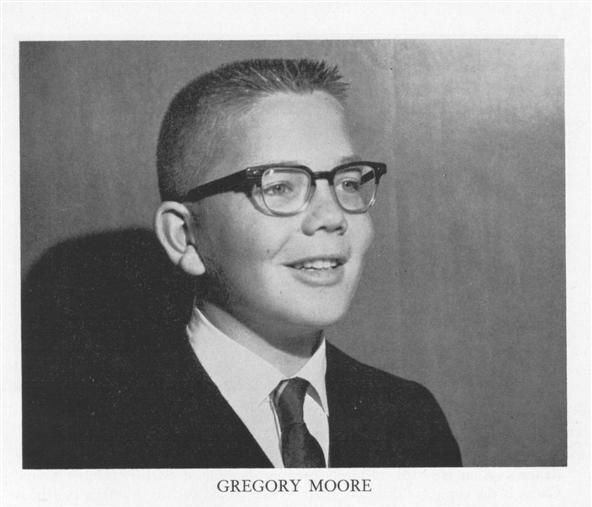
Season 9
1960-1961
Roster



November 1960 Concert
Concert Overview
The October 1960 concert features a rich program spanning the Romantic and Baroque periods, highlighted by the talents of young local musicians.
The concert opens with the profound Symphony No. 5 in E Minor, Op. 64 by Peter Ilyich Tchaikovsky (1840-1893). Known as one of the great examples of the Romantic period, the Fifth Symphony remains a beloved favorite among music lovers. The ensemble will perform all four movements: Andante—Allegro con anima, Andante cantabile, Allegro moderato (Valse), and Andante maestoso—Allegro vivace.
Following the intermission, the program shifts to the Baroque era with Antonio Vivaldi's (1675-1741) Concerto Grosso in D Minor, Op. 3, No. 11. This work is one of twelve concertos that comprise the composer's celebrated collection, "Harmonic Inspiration." This concerto grosso features a smaller group of soloists set against the full string ensemble. The featured soloists are:
- Catherine Ledford, Violin
- Diana Brecker, Violin
- Terry Bramel, Cello Obligato
The concert continues with the lively Dance of the Tumblers from "Snow Maiden" by Nikolay Rimsky-Korsakov (1844-1908). This opera extract, first performed in 1880, is known for its inspiration from Russian folk songs and displays a typical flair for colorful orchestration.
The final two selections bring the concert to a spirited close. Clear Track (Bahn-Frei), Galop by Eduard Strauss (1835-1916) is a brilliant, rousing piece of dance music. Concluding the evening is the famed march Stars and Stripes for Ever by the "March King," John Philip Sousa (1854-1932), which is sure to provide a memorable and vibrant finish.
This performance showcases the orchestra's versatility across different eras and features outstanding young soloists from the community.
Featured Soloists
This concert showcases the talents of two accomplished young violinists: Catherine Ledford and Diana Brecker, alongside cellist Terry Bramel, who are the soloists for Vivaldi's Concerto Grosso in D Minor.
Catherine Ledford (Violin Soloist):
Catherine Ledford is a senior at Cubberley High School and a veteran member of the orchestra, now serving as the concert mistress for both her orchestra and high school orchestra. She was also a member of the Palo Alto Chamber Orchestra last summer. Catherine was born in Santurce, Puerto Rico, on June 25, 1943. While she initially studied piano, she eventually devoted herself to the violin, studying for seven years with Mrs. Valborg Leland and other distinguished instructors. Beyond music, Catherine is very interested in history and sociology, with hobbies that include discussion groups, hiking, playing tennis, and choral work, and she also teaches violin. She plans to continue her musical education in college, with Oberlin College and Eastman School of Music being among her top choices.
Diana Brecker (Violin Soloist):
Diana Brecker is a junior at Menlo-Atherton High School, and this concert marks her fourth season with the California Youth Symphony. Born on March 28, 1945, Diana began her music studies at the age of ten with Mrs. Valborg Leland, with whom she is still studying. She holds the position of concert mistress in both the Elementary School Orchestra and the Menlo-Atherton Orchestra. She has also attended music camp at the College of Pacific and has enjoyed performing in various musical groups. Academically, Diana is a member of the California Scholarship Federation and is active in the swim program. She has also served as an officer in the Youth Group of Bethany Lutheran Church for three years. Her college plans include a double major in music and art.

March 1961 Concert
Concert Overview
The March 1961 concert presents a captivating journey through musical history, featuring works from the Italian opera stage, the Classical concerto repertoire, Spanish orchestral color, and the powerful Romantic tradition of the North.
The program opens with the lively Overture to "La Gazza Ladra" (The Thieving Magpie) by Gioachino Antonio Rossini (1792–1868). While Rossini is best known for The Barber of Seville, this overture stands alone as a popular concert piece, noted for its dramatic use of the snare drum and the composer's characteristic, exhilarating crescendi.
Next is a centerpiece of the evening: the Concerto for Piano and Orchestra No. 2 in B flat Major, Opus 19 by Ludwig van Beethoven (1770–1827). This concerto, an early work by Beethoven, is a testament to his prowess as a composer and pianist. It is presented in three movements: the energetic Allegro con brio, the soulful Adagio, and the spirited, rondo finale (Rondo—Molto allegro). The soloist for this demanding work is the talented young musician, Gregory Moore.
Following intermission, the orchestra delivers a taste of vibrant Spanish flair with España, Rhapsody for Orchestra by Emmanuel Chabrier (1841–1894). Inspired by Chabrier's travels in Spain, this lively piece is a colorful tone-picture based on the rhythms of Spanish dances, including the Jota and the Malaguena.
The program then shifts to the story-telling of the ballet Rappaccini's Daughter, based on the tale by Nathaniel Hawthorne. This segment highlights a tragic and dramatic narrative about a young man, Giovanni, who falls in love with Beatrice, the beautiful but poisonous daughter of a scientist, which ultimately ends in disaster for their love.
The concert concludes with the epic Symphony No. 1 in E minor, Op. 39 by Jean Sibelius (1865–1957). Hailing from Finland, this symphony bridges the gap between Romanticism and a burgeoning sense of national identity. Its music is characteristically Finnish, oscillating between serene, pastoral moods and rugged, surging outbursts. The four movements are: the Andante ma non troppo—Allegro energico; the spacious, heartfelt Andante ma non troppo, Lento; the Scherzo and Trio, Allegro; and the dramatic Finale. Andante opens... that culminates in a powerful conclusion.
Featured Soloist
Gregory Moore (Piano Soloist):
Gregory Moore is a 14-year-old student at Bret Harte Junior High School in Oakland. His musical journey began early, studying piano at the age of 3 with his mother, a piano teacher. His first competition was as a "Baby Artist" in the Greater Spokane (Wash.) Music Festival. While living in Spokane, Greg commuted to Seattle to study piano and composition. At the age of 9, to further his musical understanding, he took up the violin. His talent on the instrument was such that some violin judges suggested he focus solely on the violin.
Following his parents' move to the Bay Area for better musical development, Greg joined the California Youth Symphony for orchestral training and has played in the first violin section for the last two seasons. In this March concert, he steps forward as the piano soloist for Beethoven's Piano Concerto No. 2.

May 1961 Concert
Concert Overview
The May 1961 concert presents a diverse and compelling program, featuring works from the Classical and Romantic periods, with a focus on concerto movements and nationalistic music.
The concert begins with the powerful Overture to "Egmont" by Ludwig van Beethoven (1770–1827). This overture is an integral piece of the incidental music written for Goethe's tragedy. It opens with a majestic statement and speaks of the heroism of Egmont, a Dutch nobleman fighting for his nation's freedom. The work builds dramatically to a powerful climax, representing the ultimate triumph of his cause.
The program then features two brilliant concertos. The first is the Concerto for Clarinet and Orchestra by Wolfgang Amadeus Mozart (1756–1791), with soloist Jeffry Duvall. This modern concerto highlights the solo instrument in a dynamic dialogue with the large orchestra.
The second concerto selection is the Concerto for Flute and Orchestra by Wolfgang Amadeus Mozart, featuring soloist Fulton Saier. Mozart was instrumental in establishing the style of the modern concerto, and both works showcase the composer's mastery of melody and form.
Next, the orchestra performs a suite from the beloved ballet "The Nutcracker" by Peter Ilyich Tchaikovsky (1840–1893). The ballet, first performed in 1892, is presented in two acts and three scenes. The suite consists of several enchanting dances:
- Overture miniature
- March, describing the arrival of the guests at the Christmas party
- Dance of the Sugar Plum Fairy
- Russian Dance
- Arabian Dance
- Chinese Dance
- Dance of the Reed Pipes
- Dance of the Flowers
After the intermission, the program features Rumanian Rhapsody No. 1 by Georges Enesco (1881–1955). Enesco, who lived in Romania, based his two Rumanian Rhapsodies on folk songs and dances, creating a work full of national color and vigorous themes. The first rhapsody, the more popular of the two, begins with a slow, languorous theme for clarinet before transforming into a lively dance for the full orchestra.
The concert concludes with the first movement, "Finlandia," from the monumental work of the same name by Jean Sibelius (1865–1957). "Finlandia" is one of the composer's earlier works and one of his most stirring national creations. It is synonymous with the Finnish national anthem. The piece opens with a forceful statement in the brass, followed by a tender section for woodwinds, eventually building to a powerful climax in defiance of tyranny.
Featured Soloists
Fulton Saier (Flute Soloist):
Fulton Saier is a senior at Palo Alto High School and has been a member of the California Youth Symphony for four years. Born on July 30, 1943, he is the son of Dr. and Mrs. Milton Saier.
Fulton initially studied the piano before switching to the flute. He has studied the flute for the past five years with Merrill Jordan, flutist with the San Francisco Symphony and the San Francisco Woodwind Ensemble.
At school, Fulton is active in musical activities and is a member of the Block "P" Society and the Key Club. His extra-curricular activities include swimming, photography, and philately. Fulton's academic interests are in science, and this fall he plans to enroll at either Stanford University or the University of California.
Jeffrey Duvall (Clarinet Soloist):
Jeffrey Duvall is a senior at Woodside High School, concluding his second year with the Youth Symphony. He is also active in other musical groups across the Peninsula.
Born in La Jolla, California on May 23, 1943, Jeffrey undertook the study of the clarinet in Richland, Washington, at the age of nine. He has been studying with Dana Morgan of Palo Alto since 1955. His other interests include literature, outdoor activities, and teaching the clarinet to younger pupils. He plans to enter the Oberlin Conservatory of Music in September.


